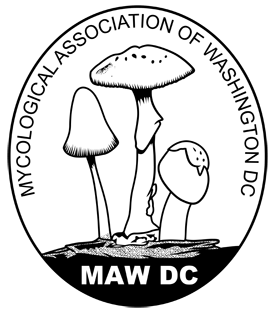 |
THE MYCOLOGICAL |
|---|---|
ASSOCIATION OF |
|
WASHINGTON, DC |
MAW holds at least a dozen mushroom forays each year. Once the weather warms, the foray frequency kicks in staring with spring morels, then summer chanterelles, onto fall hen-of-the-woods, and lots of other fascinating fungal finds from April until November. In late fall and winter, things slow down but there are usually a few outings focusing on tree or lichen identification.
Most forays last one to four hours and are held in local parks and forests. Occasionally, MAW may sponsor overnight weekend forays; one of these is our traditional annual Camp Sequanota weekend in September, where we usually find and identify nearly 200 distinct species in one weekend!
Foray Notifications and Registration
We generally schedule forays on short notice. Mushrooms are often weather dependent.
Emails announcing forays are sent only to members. You should also be able to see any scheduled forays on our website, but you must be logged in as a member to see them.
Foray participation is limited to MAW members. Registration is required and there are a limited number of spaces. If you register for a foray and decide not to attend, please cancel your registration so someone on the waiting list can take your spot.
General Foray Guidelines
- Please do not disturb mushrooms at a foray location during the prior week.
- Forays will be identification only unless otherwise specified. Please see the Park Regulations section of this page for a detailed explanation of each.
- Forays begin at 10:00am unless otherwise stated. Walks generally start on time, so please come a little early and socialize.
- Forays generally last 2-3 hours, so you may want to bring along water and a snack.
- Some foray locations may not have nearby restrooms or facilities.
- Children and minors must be accompanied by an adult.
- Useful items include a camera, hand lens, and books for identification.
- Sometimes groups can be large, and it can be quite difficult for the leader to keep track of everyone. For that reason, we encourage all participants to bring a whistle along, and in the unfortunate event you become separated from the group, your cell phone and/or a compass could be critical.
- Dress for the weather. Layers are particularly useful.
- Ticks that potentially carry Lyme disease are common in the mid Atlantic. Pants, long sleeve shirts, closed toe shoes, hats and insect repellent can all help minimize exposure to ticks, chiggers, and other annoying pests. Light colored clothing is best.
- Some terrain may be rugged, so suitable footwear is important. Walking staffs can be helpful on uneven ground.
Respecting Park Regulations
The purpose of MAW-sponsored forays is educational — to teach you how to recognize the distinguishing characteristics of mushrooms in their habitat, with the guidance of expert identifiers. Collecting for the table is not the purpose of most forays.
Most public parks, whether local, county, state or federal, have rules and regulations intended to protect habitats and delicate ecosystems, and these regulations may prohibit mushroom collecting. MAW policy is to respect park regulations, and to seek clarity when rules are uncertain. Foray leaders will not act as enforcers of park regulations, but members who collect mushrooms (or anything else) in such areas are on their own in terms of dealing with local authorities and possible fines.
Regardless of park policy, we discourage all collection methods that disturb the ecology of an area (or the mycelium of a particular fungus). However, disturbance of individual fruiting bodies is generally not harmful to the fungus itself or the larger ecosystem, and it's often the only way to identify a specimen.
Consistent with the foregoing, some of our forays are designated as "identification only" and others as "collection discretion advised."
-
Identification only — the great majority of MAW forays — will be used when park regulations prohibit the collection and/or removal of any fungi. (Rock Creek Park is a good example: the park has a clear policy that nothing can be removed from the park. MAW members should be aware that the fine for collecting mushrooms in Rock Creek Park can be $500 or more!)
-
Collection discretion advised is for instances where the administrative policy regarding collecting is somewhat uncertain.
If you are aware of areas that look like good places for MAW forays, please send an email to forays@mawdc.org so we can investigate further. MAW is particularly interested in connecting with private landowners who have an interest in knowing what fungi is growing on their property, and who would be willing to allow MAW collection forays as a way to help them learn about what they have.